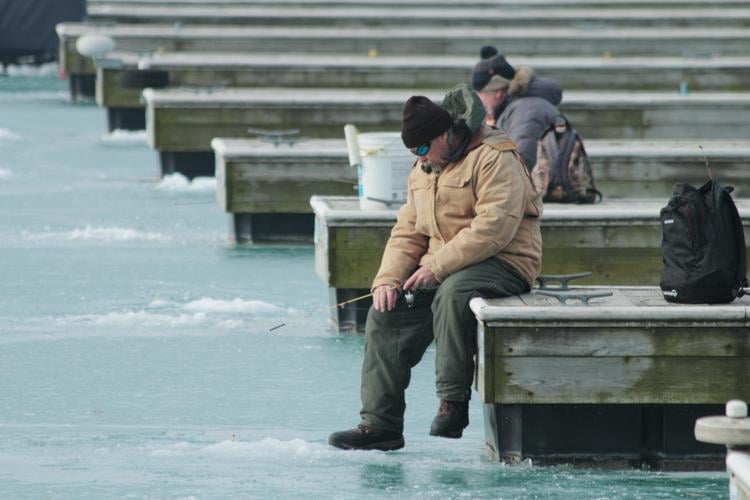The best wintertime ice fishing holes in Chicago are about eight inches wide. Cut by hand into the Lake Michigan ice, they offer robust leisure, healthy sport and tasty filets to a community of dedicated anglers who count DuSable Harbor among the finest spots around.
“You can come down here and do something in the middle of Chicago that most people wouldn’t think of,” says Chris Ranney, a DuSable regular who grew up fishing near his childhood home in Pilsen. “We have access to some of the most beautiful stuff in the city down here.”
Illinois Resident Fishing Licenses cost $15 per year. Winter access to the docks of five Chicago Harbors — Belmont, Burnham, Diversey, DuSable and Montrose — is available from Thanksgiving through March by way of a $6 Pier Pass.
Pier Passes are essentially the passcodes that open certain gates to the docks in the harbors. Henry’s Sports, Bait & Marine at 3130 S. Canal, (773) 835-1531, is Chicago’s exclusive distributor.
Ranney fishes from Chicago to Milwaukee year round. When he hits DuSable in the winter months, he arrives before sunrise with a sled full of angling gear in tow.
“I like to drill a lot of holes because I trout fish as well as perch fish out here.”
He uses a motorized 51 CC Eskimo Auger to get through the ice. It retails for about $400, cuts an eight-inch hole and looks like a knee-high red corkscrew topped with a two-handled pull start engine. For the thrifty sportster with time and muscle to spare, he recommends a hand auger “for about sixty bucks.”
Either way, he explains, the threshold should be at least eight inches wide because “you need an eight-inch hole to get some of these fish through.”
Most anglers agree that the ice should be at least three inches thick to provide safe fishing. According to Steve Palmisano, who co-owns Henry’s Sports with his brother, Tom, “We need three days of five degrees or colder to get the lake to freeze.”
The Palmisanos, who learned to fish near their family’s Bridgeport home, took over the 64-year-old business from their father. Like many enthusiasts, they combine information from others in the community with their own methods to determine the ice’s thickness.
During the mid-January heat wave, Steve explained that, “I’m still getting a confirmation that we can step out on the ice.” The store also provides daily fishing forecasts for customers.
Back on the harbor, Ranney relies on a “little network of people that’ll let us know when to come down and chop a hole.” After getting the good word, he uses a “spud bar” to test the thickness beforehand.
A spud bar is a long rod of steel that measures about four feet in length with a hammer-type end. It is used to strike the ice and, ideally, create a certain sound that indicates proper thickness.
“When you’re testing ice thickness, you’re going to spud your way out, and as you go, you’re going to get used to what a ‘thunk’ is,” he explains. “If you don’t hear the right thunk, or your spud goes through that ice, it’s not safe.”
Other essential gear includes creepers, which are basically cleats or cleated shoes “so you don’t break your neck,” and, of course, rods.
Ice fishing rods are much shorter than their warm-weather counterparts. Averaging about two feet long, the size allows greater movement within fishing shacks, on bucket perches and over small openings in the ice. Ranney demonstrates the advantage by explaining, “you’re standing over a hole,” then backing a few feet away and saying, “you don’t want to be over here.”
For bait, Palmisano recommends waxworms, which are the larvae of wax moths. “The fish are more dormant,” he explains. “They’re not really eating as large quantity, so smaller-type bait would be suitable.” Fathead minnows are another good option, he says.
When the fish are caught, all of the anglers who spoke to New Eastside News say they prefer to eat them.
Ranney likes to fry his catch in a pan with Creole batter. His fishing buddy, John Lazarich, likes to coat his with panko.
“Japanese breadcrumbs,” he says. “You know, season it up with a little salt and pepper. If you’re going to panfry it, you can use butter. Deep fry it in oil. Little Old Bay seasoning is always good.”
Palmisano enjoys “doing the Mexican way.”
“Fresh cilantro, tomato on a wheat tortilla, seasoned bread crumbs,” he says. “They’re very tasty.”
Republished from Feb. 8, 2017











(0) comments
Welcome to the discussion.
Log In
Keep it Clean. Please avoid obscene, vulgar, lewd, racist or sexually-oriented language.
PLEASE TURN OFF YOUR CAPS LOCK.
Don't Threaten. Threats of harming another person will not be tolerated.
Be Truthful. Don't knowingly lie about anyone or anything.
Be Nice. No racism, sexism or any sort of -ism that is degrading to another person.
Be Proactive. Use the 'Report' link on each comment to let us know of abusive posts.
Share with Us. We'd love to hear eyewitness accounts, the history behind an article.